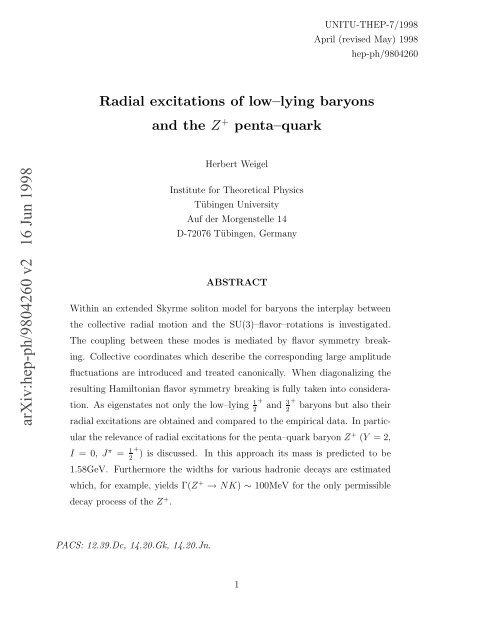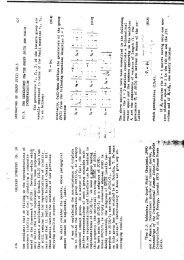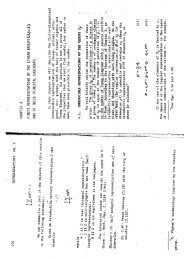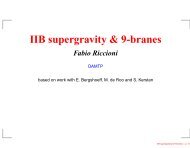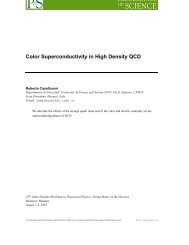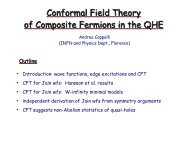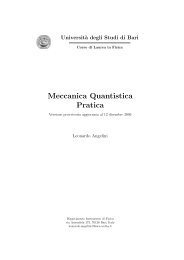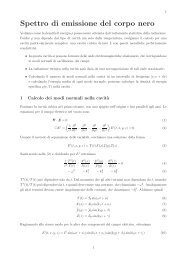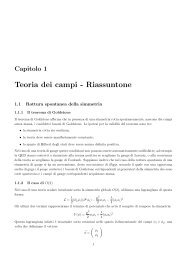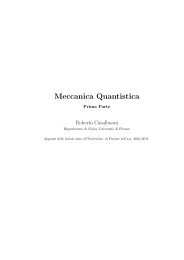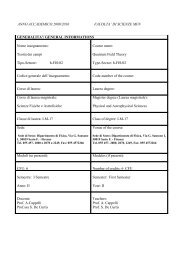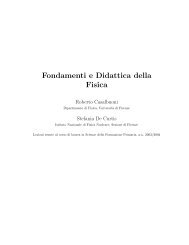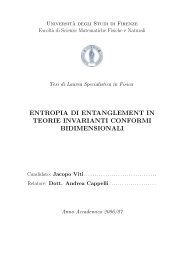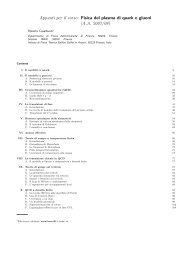arXiv:hep-ph/9804260 v2 16 Jun 1998 - Florence Theory Group
arXiv:hep-ph/9804260 v2 16 Jun 1998 - Florence Theory Group
arXiv:hep-ph/9804260 v2 16 Jun 1998 - Florence Theory Group
You also want an ePaper? Increase the reach of your titles
YUMPU automatically turns print PDFs into web optimized ePapers that Google loves.
<strong>arXiv</strong>:<strong>hep</strong>-<strong>ph</strong>/<strong>9804260</strong> <strong>v2</strong> <strong>16</strong> <strong>Jun</strong> <strong>1998</strong><br />
UNITU-THEP-7/<strong>1998</strong><br />
April (revised May) <strong>1998</strong><br />
Radial excitations of low–lying baryons<br />
and the Z + penta–quark<br />
Herbert Weigel<br />
Institute for Theoretical Physics<br />
Tübingen University<br />
Auf der Morgenstelle 14<br />
D-72076 Tübingen, Germany<br />
ABSTRACT<br />
<strong>hep</strong>-<strong>ph</strong>/<strong>9804260</strong><br />
Within an extended Skyrme soliton model for baryons the interplay between<br />
the collective radial motion and the SU(3)–flavor–rotations is investigated.<br />
The coupling between these modes is mediated by flavor symmetry break-<br />
ing. Collective coordinates which describe the corresponding large amplitude<br />
fluctuations are introduced and treated canonically. When diagonalizing the<br />
resulting Hamiltonian flavor symmetry breaking is fully taken into considera-<br />
tion. As eigenstates not only the low–lying 1+<br />
3+<br />
and baryons but also their<br />
2 2<br />
radial excitations are obtained and compared to the empirical data. In partic-<br />
ular the relevance of radial excitations for the penta–quark baryon Z + (Y = 2,<br />
I = 0, Jπ = 1+<br />
) is discussed. In this approach its mass is predicted to be<br />
2<br />
1.58GeV. Furthermore the widths for various hadronic decays are estimated<br />
which, for example, yields Γ(Z + → NK) ∼ 100MeV for the only permissible<br />
decay process of the Z + .<br />
PACS: 12.39.Dc, 14.20.Gk, 14.20.Jn.<br />
1
1. Introduction<br />
Recently there has been renewed interest in baryon states which cannot be described<br />
as simple bound states of three quarks [1, 2, 3]. One of the most prominent examples<br />
is the so–called Z + which possesses the spin and isospin quantum numbers of the Λ<br />
hyperon, however, it carries hypercharge Y = 2. When extending chiral soliton models<br />
to flavor SU(3) [4, 5] such states come about quite naturally as they are members of<br />
higher dimensional representations which do not have counterparts of equal quantum<br />
numbers in the octet or decuplet.<br />
In the context of chiral soliton models these higher dimensional representations have<br />
gained most of their recognition from the investigation of flavor symmetry breaking. Be-<br />
sides such exotic states as the Z + , the higher dimensional representations also contain<br />
states which have the spin and flavor quantum numbers of the low–lying 1+<br />
3+<br />
and 2 2<br />
baryons. One easily recognizes that flavor symmetry breaking couples states which be-<br />
long to different SU(3) representations but otherwise have identical quantum numbers.<br />
Hence these states mix with the octet and decuplet baryons as the higher dimensional<br />
representations provide a basis to obtain the exact eigenstates of the full collective Hamil-<br />
tonian [6]. As a consequence the nucleon is no longer a pure octet state but also contains<br />
sizable admixture of the corresponding members in the 10 and 27 dimensional represen-<br />
tations [7, 8]. Permissible representations are those which contain a non–strange baryon<br />
state with identical spin and isospin [9].<br />
Presumably the lightest state which does not have a counterpart of equal quantum<br />
numbers in the octet or decuplet is the above mentioned Z + . The lowest dimensional<br />
representation containing a state with the quantum numbers of the Z + is the 10. When<br />
glancing at the Young tableau of the 10, , it becomes immediately clear that such<br />
states are not simple bound states containing only three quarks. Rather they have to<br />
be interpreted as a quark–antiquark pair coupled to a three quark state. Such objects<br />
are commonly called penta–quarks. In refs [1, 2] quantitative calculations for the mass<br />
of the Z + were performed within the Skyrme model [10, 11, 12]. From fig. 2 of ref [1]<br />
one deduces that the Z + should be about 0.7GeV heavier than the nucleon. This is<br />
not too different from the estimate of ref [3] where a mass difference of 0.59GeV with<br />
respect to the nucleon was predicted. However, the latter prediction is just 100MeV<br />
above the threshold for the only accessible decay process, Z + → NK. While the result<br />
obtained in ref [1] stems from a self–contained model calculation the authors of ref [3]<br />
2
collected almost 1 all contributions up to linear order in flavor symmetry breaking to<br />
the collective Hamiltonian and the baryon wave–functions which are consistent with<br />
the general transformation properties of these objects in flavor space. The associated<br />
constants of proportionality were determined from data for the established baryons. In<br />
particular (up to flavor symmetry breaking effects) the N(1710) was identified with<br />
the nucleon state in the 10 representation in order to fix the mass difference of the<br />
states within that representation to the octet baryons. This treatment is not without<br />
ambiguities because not all baryons are rotational excitations. In such a picture one<br />
first wonders about the role of the Roper (1440) resonance which in Skyrmion models<br />
often is identified as the radial (or breathing) ¯hω excitation of the nucleon [13, 14, 15].<br />
Secondly it is then natural to consider the N(1710) resonance as the corresponding 2¯hω<br />
excitation. This scenario leads to the obvious question whether there is an interplay<br />
between radial and rotational excitations and especially to what extent this interplay<br />
effects the predictions for the Z + . The coupling between these two types of excitations<br />
is mediated by flavor symmetry breaking. For the ordinary baryons this interplay has<br />
already been discussed some time ago [<strong>16</strong>, 17]. It is the purpose of the present study<br />
to extend this approach to the Z + for which the radial motion has not been considered<br />
previously.<br />
In section 2 the simultaneous treatment of collective coordinates for radial and rota-<br />
tional motion of the soliton will be discussed for a special chiral model. Also the resulting<br />
baryon spectrum will be compared to the empirical data. In section 3 the widths for<br />
various hadronic decay modes of excited baryons will be estimated. Section 4 serves to<br />
summarize the present study.<br />
2. Breathing mode approach in flavor SU(3)<br />
In this section we will describe the treatment of large amplitude fluctuations for radial<br />
and rotational degrees of freedom in a three flavor soliton model. The simplest model<br />
within which such a study can be carried out is the Skyrme model with only pseudoscalar<br />
fields. Unfortunately, the breathing mode approach to this model does not adequately<br />
reproduce the mass differences in baryon spectrum [<strong>16</strong>]. For the present investigation we<br />
will therefore employ an extended version of the Skyrme model by supplementing it with<br />
a scalar field as motivated by the trace anomaly of QCD. Although the breathing mode<br />
approach to this model reasonably describes the baryon spectrum as well as various static<br />
1 For example, the admixture of the states of the 27–plet to the octet as well as the coupling between<br />
the Z + –type states in the 10 and 35 representations were omitted.<br />
3
aryon properties [17] it seems somewhat unmotivated. A more natural model choice<br />
would rather employ vector meson [18] or chiral quark [20] models. The reason being that<br />
these mesonic degrees of freedom need to be included in order to obtain non–vanishing<br />
neutron–proton mass differences as well as a finite axial singlet current matrix element<br />
of the nucleon [21]. In these models meson fields, which vanish classically, are induced by<br />
the collective rotation A(t) in eq (2.8). As it is yet unknown how to treat the breathing<br />
mode in the presence of these induced fields the model may be considered as an effective<br />
parameterization of massive meson fields. A particular difficulty with these induced<br />
fields is that the corresponding stationary conditions must separately be solved for every<br />
value of the scaling coordinate x in order to maintain the correct normalization of the<br />
Noether currents. In vector meson models this problem occurs already on the classical<br />
level for the time component of the ω field because its stationary condition actually<br />
is a constraint which guarantees the positivity of the classical energy functional. The<br />
incorporation of the breathing coordinate in an SU(2) vector meson model was attempted<br />
in ref [19], however, the above mentioned subtleties were ignored. In non–topological<br />
chiral quark soliton models their non–confining character may cause additional problems<br />
when treating the breathing mode dynamically because a transition to the trivial meson<br />
configuration may occur [15].<br />
To be specific we will follow the treatment of ref [17] where the soliton model not<br />
only contains the pseudoscalar mesons φ a but also an effective scalar meson field H =<br />
〈H〉exp(4σ) which is introduced to mock up the QCD anomaly [22] for the dilatation<br />
current<br />
−∂µD µ = H + <br />
i<br />
mi ¯ ΨiΨi where H = − β(g)<br />
g Ga µν Gaµν . (2.1)<br />
The vacuum expectation value 〈H〉 ∼ (0.30 − 0.35GeV) 4 can be extracted from sum<br />
rule estimates for the gluon condensate [23]. Eventually the fluctuating field σ may be<br />
identified as a scalar glueball. The effective mesonic action reads<br />
<br />
Γ =<br />
d 4 x (L0 + LSB) + ΓWZ . (2.2)<br />
The flavor symmetric part involves both the chiral field 1 U = exp(iλ a φ a /fa) as well as<br />
the scalar gluonic fluctuation σ<br />
L0 = − f2 π<br />
4 e2σ tr(αµα µ ) + 1<br />
32e<br />
+ 1<br />
2 Γ2 0 e2σ ∂µσ∂ µ σ + e 4σ<br />
<br />
2tr [αµ, αν] 2<br />
<br />
1<br />
4 [〈H〉 − 6 (2δ′ + δ ′′ <br />
)] − σ〈H〉<br />
1 Here the normalization coefficients fa refer to the pseudoscalar decay constants.<br />
4<br />
(2.3)
with αµ = ∂µUU † . Assuming the canonical dimensions d(U) = 0 and d(H) = 4 it is<br />
straightforward to verify that (2.3) yields the anomaly equation (2.1) for mi = 0. The<br />
terms which lift the degeneracy between mesons of different strangeness are comprised<br />
in<br />
<br />
LSB = tr β ′ <br />
T ˆ ′′<br />
+ β Sˆ e 2σ ∂µU∂ µ U † U + <br />
δ ′ <br />
T ˆ ′′<br />
+ δ Sˆ e 3σ U + h.c. <br />
, (2.4)<br />
where the flavor projectors ˆ T = diag(1, 1, 0) and ˆ S = diag(0, 0, 1) have been introduced.<br />
Using a sigma–model interpretation of the chiral field the coupling of the scalar field in<br />
LSB is such as to reproduce the explicit breaking in the anomaly equation (2.1) [24]. The<br />
major impact of the scalar field emerges through the factor e 3σ in the mass term of the<br />
symmetry breaking piece (2.4). As will be discussed later, this mitigates the symmetry<br />
breaking effects in the baryon sector. This factor is special to the model with the trace<br />
anomaly included since it properly accounts for the explicit breaking of the dilatation<br />
current (2.1) as the quark bilinear ¯ ΨiΨi has canonical mass dimension three.<br />
The various parameters in eqs (2.3) and (2.4) are determined from the masses and<br />
decay constants of the pseudoscalar mesons:<br />
β ′ ≈ 26.4MeV 2 , β ′′ ≈ 985MeV 2 , δ ′ ≈ 4.15 × 10 −5 GeV 2 , δ ′′ ≈ 1.55 × 10 −3 GeV 4 . (2.5)<br />
Then the only free parameters of the model are the Skyrme constant e and the glueball<br />
mass,<br />
m 2 σ = 4〈H〉 + 6(2δ′ + δ ′′ )<br />
Γ 2 0<br />
. (2.6)<br />
As in ref [17] we will use mσ ≈ 1.25GeV. Finally the scale invariant Wess–Zumino term<br />
[25] is most conveniently presented by introducing the one–form α = αµdx µ ,<br />
ΓWZ = iNc<br />
240π2 <br />
tr(α 5 ) . (2.7)<br />
The above described model possesses a static soliton solution U0(r) = exp[iτ · ˆrF(r)],<br />
σ(r) = σ0(r) which is characterized by the two radial functions F(r) and σ0(r) [22, 26].<br />
Except of unit baryon number this configuration does not carry baryonic quantum num-<br />
bers such as spin or isospin. Baryon states are commonly generated by canonical quan-<br />
tization of the collective coordinates which are introduced to describe large amplitude<br />
fluctuations. Apparently these are the rotations in coordinate and flavor spaces which<br />
are (up to flavor symmetry breaking) zero modes of the soliton. Due to the hedgehog<br />
structure of the soliton these rotations are equivalent. In addition the energy surface<br />
5
associated with scale or breathing transformations of the Skyrmion is known to be flat,<br />
at least in a large vicinity of the stationary point [13, 14]. For this reason it is suggestive<br />
to also introduce a collective coordinate for the soliton extension. Then the unknown<br />
time–dependent solution to the Euler equations is approximated by<br />
U(r, t) = A(t)U0 (µ(t)r) A † (t) and σ(r, t) = σ0 (µ(t)r) . (2.8)<br />
Substituting this parameterization into the action (2.2) yields the Lagrangian for the<br />
collective coordinates A(t) as well as x(t) = [µ(t)] −3/2<br />
L(x, ˙x, A, ˙ A) = 4 <br />
9<br />
+ 1 <br />
2<br />
a1 + a2x −4<br />
3<br />
β1x 2 + β2x 2<br />
3<br />
<br />
7<br />
Ω<br />
a=4<br />
2 a +<br />
˙x 2 − <br />
b1x 2<br />
3 + b2x −2<br />
3 + b3x 2<br />
+ 1<br />
√<br />
3<br />
2 Ω8<br />
<br />
− s1x 2 + s2x 2<br />
3 + 4<br />
9 s3 ˙x 2<br />
2<br />
<br />
3<br />
Ω<br />
a=1<br />
2 a<br />
<br />
(1 − D88) . (2.9)<br />
α1x 2 + α2x 2<br />
3<br />
Here the angular velocities A † ˙ A = (i/2) 8a=1 λaΩa as well as the adjoint representation<br />
Dab = (1/2)tr(λaAλbA † ) have been introduced. A term linear in ˙x, which would originate<br />
from flavor symmetry breaking terms, has been omitted because the matrix elements of<br />
the associated SU(3) operators vanishes when properly accounting for Hermiticity in the<br />
process of quantization [27]. The expressions for the constants a1, . . .,s3 as functionals of<br />
the chiral angle as well as their numerical values may be extracted from ref [17]. The term<br />
involving s3 causes major difficulties in the process of quantization. This contribution<br />
to L stems from the derivative type symmetry breaker in (2.4) whose influence in the<br />
soliton sector is known to be small 2 . In addition, by replacing the collective function<br />
1 −D88 with a constant of order unity the effects of this term have been estimated to be<br />
only a few percent, cf. appendix B of ref [<strong>16</strong>]. Hence the s3 term may safely be omitted.<br />
The baryon states corresponding to the Lagrangian (2.9) are obtained in a two–step<br />
procedure. In the first step flavor symmetry breaking is ignored. For convenience one<br />
furthermore defines<br />
and<br />
m = m(x) = 8<br />
9 (a1 + a2x −4 3) , b = b(x) = b1x 2<br />
3 + b2x −2<br />
3 + b3x 2 ,<br />
α = α(x) = α1x 2 + α2x 2<br />
3 , β = β(x) = β1x 2 + β2x 2<br />
3<br />
s = s(x) = s1x 2 + s2x 2<br />
3 . (2.10)<br />
2 In numerical calculations the direct contributions of this term are small. Nevertheless it is important<br />
because it has significant indirect influence since it provides the origin for different decay constants,<br />
fπ ≈ 1.2fK. Compared to the un<strong>ph</strong>ysical case fπ = fK the mass type symmetry breaker increases by<br />
about 50% because δ ′′ = (2f 2 K m2 K − f2 πm 2 π)/4. The δ ′′ term is contained in s1.<br />
6
Then the flavor symmetric part of the collective Hamiltonian<br />
1<br />
H = −<br />
2 √ mα3β4 ∂<br />
∂x<br />
<br />
α 3 β 4<br />
m<br />
<br />
∂ 1 1<br />
+ b + − J(J + 1) +<br />
∂x 2α 2β<br />
1<br />
2β C2(µ) − 3<br />
8β<br />
+ s(2.11)<br />
is diagonalized for a definite SU(3) representation µ. Due to the hedgehog structure<br />
of the static configuration U0 and σ0, the allowed representations must contain at least<br />
one state with identical spin and isospin. In addition, this state must have vanishing<br />
strangeness [4, 5]. For definiteness we denote the eigenvalues of (2.11) by Eµ,nµ and the<br />
corresponding eigenstates by |µ, nµ〉, where nµ labels the radial excitations. Actually the<br />
eigenstates factorize |µ, nµ〉 = |µ〉|nµ〉. In this language the nucleon corresponds to |8, 1〉<br />
while the first radially excited state, which is commonly identified with the Roper (1440)<br />
resonance, would be |8, 2〉. Of course, we are interested in the role of states like |10, n 10 〉<br />
since in particular this tower contains the state with the quantum numbers of the Z + . In<br />
the second step the symmetry breaking part will be taken into account. This is done by<br />
employing the states |µ, nµ〉 as a basis to diagonalize the complete Hamiltonian matrix<br />
Hµ,nµ;µ ′ ,n ′<br />
µ ′ = Eµ,nµδµ,µ ′δnµ,n ′<br />
µ ′ − 〈µ|D88|µ ′ 〉〈nµ|s(x)|n ′ µ ′〉 . (2.12)<br />
The flavor part of these matrix elements is computed using SU(3) Clebsch–Gordon<br />
coefficients 3 while the radial part is calculated numerically using the appropriate eigen-<br />
states of (2.11). Of course, this can be done for each isospin multiplet separately, i.e.<br />
flavor quantum numbers are not mixed. The <strong>ph</strong>ysical baryon states |B, m〉 are finally<br />
expressed as linear combinations of the eigenstates of the symmetric part<br />
|B, m〉 = <br />
µ,nµ<br />
C (B,m)<br />
µ,nµ |µ, nµ〉 . (2.13)<br />
The corresponding eigenenergies are denoted by EB,m. The nucleon |N, 1〉 is then identi-<br />
fied as the lowest energy solution with the associated quantum numbers, while the Roper<br />
is defined as the next state (|N, 2〉) in the same spin – isospin channel. Turning to the<br />
quantum numbers of the Λ provides not only the energy EΛ,1 and wave–function |Λ, 1〉<br />
of this hyperon but also the analogous quantities for the radially excited Λ’s: EΛ,m and<br />
|Λ, m〉 with m ≥ 2. These calculations are repeated for the other spin – isospin channels<br />
yielding the spectrum not only of the ground state 1+<br />
3+<br />
and baryons but also their<br />
2 2<br />
radial excitations. Of course, flavor symmetry breaking couples all possible SU(3) repre-<br />
sentations. When diagonalizing (2.12) we consider the basis built by the representations<br />
3 The Clebsch–Gordon coefficients not provided in ref [28] are numerically computed as described in<br />
footnote 14 of ref [<strong>16</strong>] based on the Euler angle decomposition of ref [6].<br />
7
Table 2.1: The mass differences with respect to the nucleon (939MeV) of the eigenstates<br />
of the Hamiltonian (2.12). Experimental data are taken from [29], if available. It should<br />
be remarked that even single–star resonances have been included. The notation for the<br />
states appearing in this table is defined in eq (2.13). All numbers are in MeV.<br />
B m = 0 m = 1 m = 2<br />
e=5.0 e=5.5 expt. e=5.0 e=5.5 expt. e=5.0 e=5.5 expt.<br />
N Input 413 445 501 836 869 771<br />
Λ 175 173 177 657 688 661 1081 1129 871<br />
Σ 284 284 254 694 722 721 1068 1096 838<br />
Ξ 382 380 379 941 971 — 1515 1324 —<br />
∆ 258 276 293 640 680 661 974 1010 981<br />
Σ∗ 445 460 446 841 878 901 1112 1148 1141<br />
Ξ∗ 604 617 591 1036 1068 — 1232 1269 —<br />
Ω 730 745 733 1343 1386 — <strong>16</strong>63 1719 —<br />
8, 10, 27, 35, 64, 81, 125, 154 for the 1+<br />
baryons and 10, 27, 35, 35, 64, 28, 81, 81<br />
2<br />
125, 80 154, 254 for the 3+<br />
baryons. For the breathing degree of freedom we include<br />
2<br />
basis states which are up to 4GeV above the ground states of the flavor symmetric piece<br />
(2.11), i.e. |8, 1〉 and |10, 1〉 for the 1<br />
2<br />
+ 3+<br />
and baryons, respectively. This seems to be<br />
2<br />
sufficient to get acceptable convergence when diagonalizing (2.12). It should be noted<br />
that not all of the above SU(3) representations appear in each isospin channel. For<br />
example, there is no Λ–type state in the 10.<br />
In table 2.1 the predictions for the mass differences 4 with respect to the nucleon of<br />
the eigenstates are shown for two values of the Skyrme parameter e. The agreement with<br />
the experimental data is quite astonishing, not only for the ground state but also for the<br />
radial excitations. Only the prediction for the Roper resonance (|N, 2〉) is on the low side.<br />
This is common to the breathing mode approach [13, 14]. As far as data are available<br />
the other first excited states are quite well reproduced. On the other hand for the 1+<br />
2<br />
baryons the energy eigenvalues for the second excitations overestimate the corresponding<br />
empirical data somewhat. However, the pattern M(|N, 2〉) < M(|Σ, 2〉) < M(|Λ, 2〉) is<br />
reproduced. The predicted Σ and Λ type states with m = 2 are about 200MeV too<br />
high. For the 3+<br />
baryons with m = 2 the agreement with data is much better, on the<br />
2<br />
3% level. On the whole, the present model gives fair agreement with the available data.<br />
This certainly supports the picture of coupled radial and rotational modes.<br />
Above we stated that the factor e 3σ in eq (2.4) mitigated the effects of flavor symme-<br />
4 In soliton models commonly only mass differences are considered to avoid the inclusion of meson<br />
loop corrections which reduce the absolute values substantially [30].<br />
8
Table 2.2: The strange content fractions XS for the J = 1/2 ground state compared to<br />
the flavor symmetric case (pure octet). Up to the provided precision the results coincide<br />
for e = 5.0 and e = 5.5. The differences to the pure octet case indicate the significance<br />
of the higher dimensional representations.<br />
N Λ Σ Ξ<br />
e = 5.0 0.<strong>16</strong> 0.25 0.30 0.37<br />
Octet 0.23 0.30 0.37 0.40<br />
try breaking in the soliton sector. For the soliton solution the σ field is always negative.<br />
Hence the contribution of the mass–type symmetry breaker to s(x) in eq (2.10) is sig-<br />
nificantly reduced as compared to the pure pseudoscalar case. As already discussed,<br />
the mass–type symmetry breaker strongly dominates over the kinetic–type, which is<br />
suppressed by the factor e 2σ . Since applying the breathing mode approach to the pure<br />
pseudoscalar model (i.e. σ ≡ 0) overestimates the flavor symmetry breaking in the<br />
baryon mass differences [<strong>16</strong>], the incorporation of the scalar glueball field improves on<br />
the predicted baryon spectrum [17]. In the pure Skyrme model a reduction of symmetry<br />
breaking effects can be gained by decreasing the Skyrme constant e. Unfortunately this<br />
also lowers the difference between the nucleon and the ∆ masses. As can be observed<br />
from table 1 in ref [<strong>16</strong>] an overall satisfactory picture cannot be obtained in the breathing<br />
mode approach to the pure pseudoscalar model.<br />
In figure 2.1 the dominant pieces of the radial wave–functions<br />
f (B,m)<br />
µ<br />
(x) = <br />
nµ<br />
C (B,m)<br />
µ,nµ f(0) µ,nµ (x) (2.14)<br />
are shown for the 1+<br />
(0)<br />
ground states. Here f (x) denote the radial eigenfunctions of the<br />
2<br />
µ,nµ<br />
flavor symmetric formulation (2.11) multiplied by (α3 (x)β4 (x)/m(x)) (1/4) [<strong>16</strong>]. It should<br />
be noted that these radial wave–functions are normalized with respect to a metric m(x)<br />
which is singular at x = 0, cf. eq (2.10). Hence all wave–functions vanish at that<br />
particular point. We observe that these ground states are dominated by the radial<br />
ground state in the octet representation. Nevertheless the contributions from the higher<br />
dimensional representations are not negligible either. This can also be seen from the<br />
strange content fractions of these baryons. This quantity can be associated with the<br />
matrix elements XS = 〈(1 − D88)/3〉 [31]. The sizable deviations from the pure octet<br />
results are shown in table 2.2. It is also interesting to note that the strange content<br />
fraction for the Roper and the N(1710) respectively decrease from 23% to 14% and from<br />
25% to 19% (e = 5.0) due to flavor symmetry breaking.<br />
9
0.50<br />
0.40<br />
0.30<br />
0.20<br />
0.10<br />
Nucleon wave − functions<br />
µ=8<br />
µ=10−bar<br />
µ=27<br />
µ=35−bar<br />
0.00<br />
0.0 2.0<br />
x<br />
4.0 6.0<br />
0.50<br />
0.40<br />
0.30<br />
0.20<br />
0.10<br />
Λ wave − functions<br />
µ=8<br />
µ=27<br />
0.00<br />
0.0 2.0<br />
x<br />
4.0 6.0<br />
0.50<br />
0.40<br />
0.30<br />
0.20<br />
0.10<br />
Σ wave − functions<br />
µ=8<br />
µ=10−bar<br />
µ=27<br />
µ=35−bar<br />
0.00<br />
0.0 2.0<br />
x<br />
4.0 6.0<br />
0.50<br />
0.40<br />
0.30<br />
0.20<br />
0.10<br />
Ξ wave − functions<br />
µ=8<br />
µ=27<br />
0.00<br />
0.0 2.0<br />
x<br />
4.0 6.0<br />
Figure 2.1: The contributions of the lowest SU(3) representations µ to the radial parts<br />
of the ground state baryons with J = 1/2. Here e = 5.0 is used.<br />
In figure 2.2 the dependence on the scaling variable for the first two excited nucleon<br />
states is shown. As expected the Roper is dominantly a radial excitation of the octet.<br />
However, there are also sizable contributions of the radial ground states in the higher<br />
dimensional representations. For the state which we want to associate with the N(1710)<br />
we indeed find that the 10 contributes the major share. On the other hand the admixture<br />
of the 2¯hω excitation of the octet is not negligible either. Hence the identification of the<br />
N(1710) with |N, 10〉 appears as an over–simplification.<br />
It should be noted that the model predicts yet another eigenstate of (2.12) just<br />
about 50MeV above the state we just identified as N(1710). This is essentially the<br />
linear combination of the |N, 10〉 and the 2¯hω radial excitation of the octet which is<br />
orthogonal to the wave–function shown in the right panel of figure 2.2. Although the<br />
10
0.40<br />
0.20<br />
0.00<br />
−0.20<br />
Roper wave − functions<br />
−0.40<br />
0.0 2.0 4.0 6.0<br />
x<br />
µ=8<br />
µ=10−bar<br />
µ=27<br />
µ=35−bar<br />
0.40<br />
0.20<br />
0.00<br />
−0.20<br />
N(1710) wave − functions<br />
−0.40<br />
0.0 2.0 4.0 6.0<br />
x<br />
µ=8<br />
µ=10−bar<br />
µ=27<br />
µ=35−bar<br />
Figure 2.2: The contributions of the lowest SU(3) representations µ to the excited states<br />
with nucleon quantum numbers. Here e = 5.0 is considered.<br />
Particle Data <strong>Group</strong> (PDG) [29] gives 2.1GeV for the average value of the mass of the<br />
third resonance in the P11 channel there is also an analysis [32] of the data which yields<br />
a significant lower resonance position, 1.885 ± 0.030GeV. In particularly one should<br />
note that the four–pole fit of ref [33] predicts two states around 1.75GeV in the P11<br />
channel which are less than 10MeV apart. We find a similar scenario on the Σ channel,<br />
although about 200MeV too high. In table 2.1 the |Σ, m = 2〉 state has been considered<br />
to be the Σ(1770) P11. In addition we observe a Σ–type state 1.135GeV above the<br />
nucleon for e = 5.0 and 1.181GeV for e = 5.5. Eventually this could be identified<br />
with the Σ(1880) P11 [29] 5 . One should bear in mind that the analyses leading to this<br />
two–star resonance are somewhat dated and are spread between 6 1.826 ± 0.020 [34] and<br />
1.985 ±0.050GeV [35]. Nevertheless one is inclined to consider the predicted two almost<br />
degenerate states in that energy regime as a nice feature of the present model. In the Λ<br />
and Ξ channels no such doubling is observed as the 10 does not contain states with the<br />
quantum numbers of these baryons. However, this representation contains a Y = −1,<br />
I = 3 state which is not considered here.<br />
2<br />
States with the quantum numbers of the Z + exist besides in the 10 also in the<br />
35, 81 and 154 representations. Actually these are always the complex conjugates of<br />
representations which also contain Ω–type states. This is a direct consequence of the<br />
5 In ref [3] this state was speculated to be the pure |Σ, 10〉.<br />
6 Cf. the references compiled by the PDG: p. 652 in [29].<br />
11
complex conjugation being equivalent to a reflection at the Y = 0 axis. Upon this<br />
reflection the Ξ ∗ –type state is transformed into a nucleon type state which then satisfies<br />
the conditions J = I and S = 0 while the Ω becomes the Z + .<br />
The resulting radial structure of the Z + wave–function is displayed in the left panel<br />
of figure 2.3. We recognize that the higher dimensional contributions are not negligible.<br />
0.40<br />
0.30<br />
0.20<br />
0.10<br />
Z +<br />
wave − functions<br />
0.00<br />
0.0 2.0 4.0 6.0<br />
x<br />
µ=10−bar<br />
µ=35−bar<br />
µ=81−bar<br />
µ=154−bar<br />
0.40<br />
0.30<br />
0.20<br />
0.10<br />
0.00<br />
∆ wave − functions<br />
−0.10<br />
0.0 2.0 4.0 6.0<br />
x<br />
µ=10<br />
µ=27<br />
µ=35<br />
µ=35−bar<br />
Figure 2.3: The contributions of the lowest SU(3) representations µ to the penta–quark<br />
baryon Z + . Also the wave–functions for the ∆–resonance are shown. Here e = 5.0 is<br />
considered.<br />
In particular the amplitude of the 35 is almost half as large as the leading order piece<br />
residing in the 10. It should be noted that up to only first order in flavor symmetry<br />
breaking the Z + states in 10 and 35 have non–vanishing overlap. In the estimate of<br />
ref [3] this overlap was not taken into account. As the second order perturbation to the<br />
energy of a ground state is always negative one would speculate that the mass of the Z +<br />
would even be reduced when this effect was included. However, here the mass of the Z + is<br />
predicted to be 1.57GeV and 1.59GeV for e = 5.0 and e = 5.5, respectively. This is 40 to<br />
60MeV larger than the result of ref [3]. As compared to the octet, the centrifugal barrier<br />
for states in the 10 representation is stronger. Hence the corresponding eigenfunctions<br />
of (2.11) are localized at larger values of the scaling variable x. This effect can be<br />
observed by comparing the radial wave–functions in figures 2.1 and 2.3. In turn it leads<br />
to more sizable contributions associated with flavor symmetry breaking (2.12) than in<br />
the model without breathing mode. In order to further illuminate the statement that<br />
the Z + wave–function is pushed to larger values of x also the wave–function of the ∆<br />
12
is shown in figure 2.3. We note that although in leading order the Z + and ∆ have<br />
the same Casimir eigenvalue C2(10) = C2(10) = 6 the centrifugal barrier is smaller<br />
for the ∆ because α(x) > β(x) in the Hamiltonian (2.11). It should be remarked that<br />
singular behavior of the metric m(x), which enters the evaluation of all matrix elements,<br />
intensifies this effect. The increase of the mass due to the Z + being localized at larger<br />
x is a leading order effect in flavor symmetry breaking which effects the strange content<br />
fraction Xs. In the flavor symmetric case we find Xs = 25% for the Z + . When the flavor<br />
symmetry breaking effects are included it is reduced to about 18%. This implies that<br />
the Z + possesses a significant cloud of non–strange mesons. It is finally worthwhile to<br />
note that the first excited state in the Z + channel is at 2.02(2.07)GeV for e = 5.0(5.5).<br />
3. Estimate of Widths<br />
The soliton model described in the preceding section has been shown to reasonably<br />
describe not only the spectrum of the low–lying 1+<br />
3+<br />
and baryons but also various<br />
2 2<br />
baryon static properties. In particular the inclusion of the radial collective coordinate<br />
properly reproduces the experimentally observed deviation from U–spin symmetry of the<br />
predictions for the baryon magnetic moments [<strong>16</strong>, 17]. This deviation remains unobserved<br />
as long as flavor symmetry breaking effects on the extension of the soliton are not included<br />
[36, 5]. Hence one is inclined to assume that also the widths for various decays of the<br />
predicted states (resonances) are reasonably described. Here we are interested in the<br />
decay Z + → K (+,0) N which should be mediated by a pseudoscalar Yukawa coupling.<br />
In soliton models such a coupling is not directly obtainable as to leading order in 1/NC<br />
terms linear in the meson fluctuations vanish by definition. One possibility to avoid this<br />
problem is to adopt the Goldberger–Treiman relation, which relates the relevant coupling<br />
constant to the axial charge. Along that line the matrix element of D33 was used in ref<br />
[11] to predict the amplitude for the decay ∆ → Nπ and relate it to the πN coupling<br />
constant. In the present model the situation is even less transparent as we also demand<br />
the dependence of the transition operator on the scaling variable x. Assuming, for the<br />
time being, that we have obtained the relevant operator in the space of the collective<br />
coordinates the corresponding matrix element will yield the coupling constant GB ′ →Bφ<br />
associated with the decay of the resonance B ′ to another baryon state B and a meson<br />
φ. This coupling constant then enters the width via<br />
Γ(B ′ → Bφ) = 3G2 B ′ →Bφ<br />
8πMB ′MB<br />
13<br />
|p φ| 3 . (3.1)
Here |p φ| is the momentum of the outgoing meson in the rest frame of the resonance<br />
B ′ . The cubic dependence on |p φ| arises as the amplitude (which enters the width<br />
quadratically) of the pseudoscalar Yukawa coupling is linear in |p φ|. In addition the<br />
<strong>ph</strong>ase–space provides one power in that momentum. For states which are located just<br />
slightly above threshold this cubic dependence on the momentum rather than the value<br />
of the coupling constant will be the most crucial ingredient to calculate the width of<br />
B ′ . Hence it is sufficient to get a rough estimate for the coupling constants in order to<br />
allow for a comparison of various decay processes. It is therefore suggestive to adopt the<br />
following strategy: For the flavor part of the relevant operator we adopt Dφ,3 which in<br />
leading order 1/NC is the only possible operator compatible with flavor covariance. For<br />
the scaling piece we will consider different powers, µ −n = x 2n/3 . Different values for the<br />
power n can be motivated by the long range behavior of the pseudoscalar fields which<br />
built up the soliton. Taking straightforwardly the matrix element of the pion field would<br />
result in n = 3 from the spatial integration. Considering that due to the pseudoscalar<br />
character of that field the Fourier transformation involves the s<strong>ph</strong>erical Bessel function<br />
j1(qr) would add a factor r to the integrand [37], whence n = 4. On the other hand one<br />
could argue that in the chiral limit (mπ = 0) the coupling constant is directly related to<br />
the amplitude of the soliton at large r [38]. As the massless pion field decays like 1/r 2<br />
one would be inclined to adopt n = 2. In this way we will obtain at least the generic<br />
behavior of the coupling constant while the major ingredient for the decay width, the<br />
momentum |p φ|, is computed from the spectrum calculated in the preceding section. The<br />
widths of various decays will finally be compared by adjusting the absolute magnitude to<br />
the process ∆ → Nπ, i.e. Γ(∆ → Nπ) ≈ 120MeV. This corresponds to a multiplicative<br />
normalization of the decay constants which is also suggested by large–NC considerations<br />
[39].<br />
To be precise, we will compute matrix elements of the form<br />
GB ′ →Bφ = C∆〈B ′ m ′ |x 2n/3 Da3|Bm〉, (3.2)<br />
with C∆ fitted to Γ(∆ → Nπ). Here we take a = 3 and a = 4 ± i5 for strangeness<br />
conserving (φ = π) and strangeness changing (φ = K) decays, respectively. The latter<br />
case is only relevant for the decay of the Z + . The baryon wave–functions are those of<br />
eq (2.13) which stem from diagonalizing the full collective Hamiltonian. The resulting<br />
widths as well as the ratio of the coupling constants between the ∆ and the nucleon to<br />
the pion are shown in table 3.1. Let us recall that as Γ(∆ → Nπ) is kept fixed one<br />
14
Table 3.1: Decay widths (in MeV) and ratio of πN and π∆ coupling constants using the<br />
matrix elements (3.2). The decay width Γ(∆ → Nπ) ≈ 120MeV is fixed. R denotes the<br />
Roper (1440) resonance. Experimental data are extracted from ref [29].<br />
e=5.0 e=5.5 expt.<br />
n 4 3 2 4 3 2<br />
Σ ∗ → Σπ 1 1 1 2 2 2 4 ± 1<br />
Σ ∗ → Λπ 33 38 42 37 38 43 32 ± 4<br />
Ξ ∗ → Ξπ 5 7 10 7 9 11 10 ± 2<br />
R → Nπ 429 281 156 424 260 145 200 to 320<br />
R → ∆π 4 2 2 9 6 3 50 to 80<br />
Z + → NK 118 121 124 130 124 126 ?<br />
gπNN/gπN∆ 0.77 0.79 0.83 0.77 0.79 0.83 0.68<br />
should consider gπN∆ as an input quantity.<br />
Apparently we find that, at least for the widths of ground state baryons, the de-<br />
pendence on the power n is only moderate. The reason is that for these baryons the<br />
major contribution to the scaling part of the matrix element stems from the vicinity of<br />
x = 1. In addition the shape of the wave–functions of these baryons is quite similar in<br />
that region, cf. figure 2.1. Hence the effect of different n is compensated by normalizing<br />
to Γ(∆ → Nπ). Regarding the crudeness of our estimate the predicted widths for the<br />
processes Σ ∗ → Σπ, Σ ∗ → Λπ and Ξ ∗ → Ξπ as well as the ratio gπNN/gπN∆ are in fair<br />
agreement with the empirical data. The case of the Roper (1440) resonance is different.<br />
Here we recognize a strong dependence on the power n. This is a consequence of the<br />
associated breathing mode wave–function having a node around x = 1.5 − 2.0, cf. fig-<br />
ure 2.2. For the decay R → Nπ the value n = 3 appears to be reasonable. However,<br />
one should be careful with such a conclusion as the too low prediction for the mass of<br />
the Roper might falsify the result for the width. This is even more pronounced for the<br />
process R → ∆π. Table 3.1 indicates that at least one order of magnitude is missing<br />
for the width. For the masses given in table 2.1 the momentum of the outgoing pion<br />
is 66 (91)MeV for e = 5.0(5.5). Substituting the <strong>ph</strong>ysical momentum, |p π| = 147MeV<br />
could account for an order of magnitude for the decay width (3.2). Again we recognize<br />
that the decay widths are significantly more sensible to the mass parameters than to<br />
the decay constants, in particular for processes with kinematics just above threshold.<br />
For the decay of the Z + , the process we are mostly interested in, we recognize neither<br />
a strong dependence on the power n nor on the model parameter e. From the results<br />
shown in table 3.1 it seems fair to conclude that the width of the process Z + → NK<br />
15
Table 3.2: Decay widths (in MeV) and ratio of πN and π∆ coupling constants using the<br />
matrix elements (3.3). The decay width Γ(∆ → Nπ) ≈ 120MeV is fixed. R denotes the<br />
Roper (1440) resonance. Experimental data are extracted from ref [29].<br />
follows closely the width of ∆ → Nπ.<br />
e=5.0 e=5.5 expt.<br />
Σ ∗ → Σπ 2 3 4 ± 1<br />
Σ ∗ → Λπ 64 63 32 ± 4<br />
Ξ ∗ → Ξπ 22 23 10 ± 2<br />
R → Nπ 71 71 200 to 320<br />
R → ∆π 2 3 50 to 80<br />
Z + → NK 82 83 ?<br />
gπNN/gπN∆ 0.70 0.69 0.68<br />
Rather than just identifying the matrix element of the pseudoscalar field with the<br />
coupling constant GB ′ →Bφ one could imagine to compute this coupling constant via the<br />
axial current and adopt the Goldberger–Treiman relation. In three flavor space this is<br />
different from the above approach because an additional operator, whose contribution to<br />
GB ′ →Bφ is suppressed by 1/NC, enters the calculation. In this approach one calculates<br />
the matrix elements<br />
GB ′ →Bφ ∼ 〈B ′ m ′ ⎧<br />
⎨<br />
| g1x<br />
⎩<br />
4/3 x<br />
+ g2 Da3 + g3<br />
2/3<br />
⎫<br />
7 ⎬<br />
d3αβDaαRβ |Bm〉 . (3.3)<br />
β(x)<br />
⎭<br />
α,β=4<br />
The constants g1, g2 and g3 are functionals of the static soliton and can be extracted<br />
from refs [<strong>16</strong>, 17]. The additional operator involves the right SU(3)–generators Ra. As<br />
it is multiplied by the inverse moment of inertia for rotations into strange direction the<br />
contribution of this operator to the coupling constant will be suppressed by 1/NC. Hence<br />
the adjustment of the coupling constants to the decay ∆ → Nπ in the spirit of the large–<br />
NC expansion [39] requires to only normalize g1 and g2 rather than the whole matrix<br />
element (3.3). The numerical results for that calculation are shown in table 3.2. The<br />
operator (3.3) does not seem to be very well suited in particular because the width for<br />
the Roper decaying into a nucleon and a pion is significantly underestimated. We note<br />
that the dependence on the momentum of the outgoing meson cannot be made respon-<br />
sible for the short–coming in this process as the resonance is far away from threshold.<br />
For e = 5.5 we have |p π| = 354MeV which is not too different from the <strong>ph</strong>ysical value<br />
of 396MeV. Hence using the <strong>ph</strong>ysical masses would at best give a 40% increase of the<br />
width. Also the widths for the decays Σ ∗ → Λπ and Ξ ∗ → Ξπ turn out to be somewhat<br />
too large. On the other hand the width for Z + is slightly reduced as compared to the use<br />
<strong>16</strong>
of eq (3.2). This is mainly due to the fact that the two SU(3) operators in (3.3) interfere<br />
destructively for the state |Z + , 10〉; contrarily they interfere constructively for the or-<br />
dinary baryons. To be precise, 〈∆, 10|D33|N, 8〉 = (1/2)〈∆, 10| 7 α,β=4 d3αβD3αRβ|N, 8〉<br />
while 〈Z + , 10|DK3|N, 8〉 = −(1/2)〈Z + , 10| 7 α,β=4 d3αβDKαRβ|N, 8〉.<br />
To summarize this section it seems reasonable to state that the breathing mode<br />
approach to the Z + predicts a width of that state of the order of 100MeV. This is con-<br />
siderably larger than the prediction of 15MeV found in ref [3]. As discussed intensively,<br />
a major reason for this difference is not the difference in the coupling constant for the<br />
process Z + → KN but rather the larger mass found for the Z + in the present approach.<br />
As compared to ref [3] the result for the mass of the Z + has increased only moderately by<br />
50MeV. Nevertheless it has noticeable consequences for the width of the only possible<br />
decay mode of this penta–quark state, Z + → NK. The momentum of the outgoing<br />
kaon grows from |p K| = 254MeV to 320MeV increasing the width by a factor of two<br />
as for processes which are just above threshold the momentum of the outgoing meson<br />
is a quickly rising function of the resonance position. In order to further compare the<br />
width of the Z + with the result of ref [3] it should be noted that such a comparison<br />
should concern the 80MeV displayed in table 3.2 because those authors also included<br />
the 7 α,β=4 d3αβDaαRβ operator. As discussed this operator lowers the prediction for the<br />
width of the Z + due to the destructive interference with the leading operator Da3. The<br />
moment of inertia for rotations into strange directions (β(x)) appears in the denominator<br />
of the additional operator. Hence the contribution of this operator will be most sensible<br />
to the small–x shape of the wave–function. As already discussed, the wave–function for<br />
the Z + penta–quark is more pronounced at larger values of x due to the angular barrier<br />
being stronger for states in the higher dimensional SU(3) representations. As indicated<br />
in figure 2.3 this is also the case when we compare with the ∆ wave–function whose<br />
matrix elements set the scale for our estimate of the width. As a result the contribution<br />
of the additional SU(3) operator is reduced even further. However, this is only a 20–30%<br />
effect and still does not explain the full discrepancy with ref [3]. At this point one should<br />
note that in ref [3] the numerical results for the widths of the 3+<br />
1 baryons are erroneous .<br />
2<br />
1 For example, for the process ∆ → Nπ the use of eq ([3]:42) together with the empirical values<br />
for the masses of the involved hadrons and the suggested coupling constant G0 = 19 yields a width of<br />
64MeV rather than the alleged 110MeV. However, the expression ([3]:56) for the width of the Z + has<br />
been worked out correctly. As an attempt to locate the possible error it could be remarked that the<br />
replacement of the factor M2/M1 by its inverse in eq ([3]:49) yields the numerical results presented in<br />
eqs ([3]:42)–([3]:45) for the decay widths of the 3/2 + baryons. The analogous replacement in eq ([3]:56)<br />
results in a Z + width of about 40MeV [40].<br />
17
As those overestimated widths have subsequently been employed to set the overall scale<br />
this is likely to be the reason for the remaining discrepancy.<br />
4. Conclusions<br />
In the present study we have investigated the coupling between radial and (flavor)<br />
rotational motion of a chiral soliton in flavor SU(3). Upon canonical quantization of<br />
the corresponding collective coordinates this approach not only describes the spectrum<br />
of the low–lying 1+<br />
3+<br />
and baryons but also that of the excited states in the respec-<br />
2 2<br />
tive channels. Besides mixing of various SU(3) representations the model in particular<br />
may account for an eventual resonance doubling [33] in the nucleon P11 channel around<br />
1.75GeV. A similar scenario is observed for the Σ channel. These results provide addi-<br />
tional support for identifying baryon states in the 10 representation of flavor SU(3) with<br />
observed resonances. Subsequently this picture leads to the question of properly identi-<br />
fying those baryon states in such higher dimensional representations which do not have<br />
counterparts in the octet or decuplet. In this respect the Z + (Y = 2, I = 0, Jπ = 1+<br />
) 2<br />
is the most interesting candidate as probably being the lightest one. Previously [3] this<br />
state was considered to be a pure 10 baryon. That calculation, however, was not a full<br />
model calculation but rather a compilation of possible terms allowed by the flavor sym-<br />
metries of the model. The constants of proportionality were determined from the known<br />
baryon spectrum and radial degrees of freedom were frozen. In this treatment it seems<br />
doubtful to ad hoc identify of the N(1710) (potentially a radially excited nucleon) with<br />
the nucleon state in the 10 representation. Here we have reflected on that assumption by<br />
carrying out a full model calculation and em<strong>ph</strong>asizing on the admixture of both, higher<br />
dimensional SU(3) representation as well as radially excited baryon states which other-<br />
wise have identical quantum numbers. It should be noted that both types of admixture<br />
are mediated through flavor symmetry breaking. Despite these major extensions of the<br />
model treatment, the present prediction for the mass of the Z + , 1.58GeV, is only about<br />
50MeV higher than that of ref [3] but still about 60MeV lower than the value found in<br />
ref [1]. As discussed, in the soliton model the determination of the coupling constants<br />
for various decays bears quite some uncertainties, nevertheless the model calculations<br />
suggest Γ(Z + → NK) ∼ 100MeV as an estimate for the width of the Z + . Quite a<br />
substantial uncertainty should be attributed to this value. Comparison of the different<br />
estimates collected in section 3 suggests ±30MeV. This should be considered a lower<br />
bound for the uncertainty.<br />
18
Here we have employed a soliton model which besides the pseudoscalar octet mesons<br />
contains a scalar field. This scalar field has been introduced as to mock up the QCD<br />
trace anomaly. Although this is presumably not the most natural choice for an effective<br />
meson theory, we have motivated this model from the simplicity to include the breathing<br />
degree of freedom and its previous success to reasonably describe the spectrum of the<br />
low–lying 1+<br />
3+<br />
and baryons as well as various of their static properties.<br />
2 2<br />
Finally one could object that the prediction of exotic states like Z + would completely<br />
be due to the adopted quantization scheme for the flavor degrees of freedom. In the<br />
alternative bound state approach [41] a penta–quark state with the quantum numbers<br />
of the Z + would emerge as a bound system of the soliton and a kaon, while the ordinary<br />
hyperons are considered as anti–kaons bound in the soliton background. Such penta–<br />
quark states are found to be unbound unless the kaon mass is artificially tuned to about<br />
1GeV. However, the resonance doubling found in the nucleon and Σ channels around<br />
2GeV is not without experimental support which indicates that exotic representations<br />
like the 10 indeed have <strong>ph</strong>ysical significance.<br />
Acknowledgments<br />
I am grateful for valuable discussions with R. Alkofer, H. Reinhardt, J. Schechter<br />
and H. Walliser. W. Eyrich is thanked for pointing out the relevance of the present<br />
study while visiting the Tübingen Graduiertenkolleg Hadronen und Kerne. Furthermore<br />
I would like to thank M. Polyakov for bringing ref [33] to my attention and for discussions<br />
on details of ref [3].<br />
This work is supported by the Deutsche Forschungsgemeinschaft (DFG) under con-<br />
tract Re 856/2-3.<br />
19
References<br />
[1] H. Walliser, Nucl. Phys. A548 (1992) 649.<br />
[2] H. Walliser, An Extension of the Standard Skyrme Model in Baryons as Skyrme Solitons,<br />
edited by G. Holzwarth, p. 247, World Scientific, 1994.<br />
[3] D. Diakonov, V. Petrov, and M. Polyakov, Z. Phys. A359 (1997) 305.<br />
[4] E. Guadagnini, Nucl. Phys. B236 (1984) 15;<br />
L. Biedenharn, Y. Dothan, and A. Stern, Phys. Lett. 146B (1984) 289;<br />
P. O. Mazur, M. A. Nowak, and M. Prasa̷lowicz, Phys. Lett. 147B (1984) 137;<br />
M. Chemtob, Nucl. Phys. B256 (1985) 600;<br />
G. S. Adkins and C. R. Nappi, Nucl. Phys. B249 (1985) 507;<br />
S. Jain and S. R. Waida, Nucl. Phys. B258 (1985) 713;<br />
A. Kanazawa, Prog. Theor. Phys. 77 (1987) 1240;<br />
H. Weigel, N. W. Park, J. Schechter, and Ulf–G. Meißner, Phys. Rev. D42 (1990) 3177;<br />
G. Pari, B. Schwesinger, and H. Walliser, Phys. Lett. B255 (1991) 1;<br />
N. W. Park and H. Weigel, Nucl. Phys. A541 (1992) 453;<br />
H. Weigel, R. Alkofer, and H. Reinhardt, Nucl. Phys. B387 (1992) 638;<br />
A. Blotz, D. Diakonov, K. Goeke, N. W. Park, V. Petrov, and P. V. Pobylitsa, Nucl. Phys.<br />
A555 (1993) 765.<br />
[5] For a review on chiral soliton models in the three flavor space see:<br />
H. Weigel, Int. J. Mod. Phys. A11 (1996) 2419.<br />
[6] H. Yabu and K. Ando, Nucl. Phys. B301 (1988) 601.<br />
[7] N. W. Park, J. Schechter, and H. Weigel, Phys. Lett. B244 (1989) 171.<br />
[8] H. K. Lee and D. P. Min, Phys. Lett. B219 (1989) 1;<br />
J. H. Kim, C. H. Lee, and H. K. Lee, Nucl. Phys. A501 (1989) 835.<br />
[9] A. V. Manohar, Nucl. Phys. B248 (1984) 19;<br />
A. P. Balachandran, A. Barducci, F. Lizzi, V. Rodgers, and A. Stern, Nucl. Phys. B256<br />
(1984) 525.<br />
[10] T. H. R. Skyrme, Proc. R. Soc. 127 (1961) 260.<br />
[11] G. S. Adkins, C. R. Nappi, and E. Witten, Nucl. Phys. B228 (1983) 552.<br />
[12] G. Holzwarth and B. Schwesinger, Rep. Prog. Phys. 49 (1986) 825;<br />
I. Zahed and G. E. Brown, Phys. Rep. 142 (1986) 481;<br />
G. Holzwarth, editor, Baryons as Skyrme Solitons, World Scientific, 1994.<br />
[13] C. Hajduk and B. Schwesinger, Phys. Lett. 140B (1984) 172.<br />
[14] A. Hayashi and G. Holzwarth, Phys. Lett. 140B (1984) 175;<br />
I. Zahed, Ulf–G. Meißner, and U. Kaulfuss, Nucl. Phys. A425 (1984) 526;<br />
J. Breit and C. R. Nappi, Phys. Rev. Lett. 53 (1984) 889;<br />
J. Zhang and G. Black, Phys. Rev. D30 (1984) 2015.<br />
[15] A. Abada, R. Alkofer, H. Reinhardt, and H. Weigel, Nucl. Phys. A593 (1995) 488.<br />
[<strong>16</strong>] J. Schechter and H. Weigel, Phys. Rev. D44 (1991) 29<strong>16</strong>.<br />
[17] J. Schechter and H. Weigel, Phys. Lett. B261 (1991) 235.<br />
[18] Ulf–G. Meißner, Phys. Rep. <strong>16</strong>1 (1988) 213;<br />
B. Schwesinger, H. Weigel, G. Holzwarth, and A. Hayashi, Phys. Rep. 173 (1989) 173;<br />
P. Jain, R. Johnson, Ulf–G. Meißner, N. W. Park, and J. Schechter, Phys. Rev. D37<br />
(1988) 3252.<br />
20
[19] D. Masak and T. Reichel, Phys. Rev. D42 (1990) 3246.<br />
[20] R. Alkofer, H. Reinhardt, and H. Weigel, Phys. Rep. 265 (1996) 139;<br />
C. V. Christov et al., Prog. Part. Nucl. Phys. 37 (1996) 91.<br />
[21] P. Jain, R. Johnson, N. W. Park, J. Schechter, and H. Weigel, Phys. Rev. D40 (1989)<br />
855;<br />
R. Johnson, N. W. Park, J. Schechter, V. Soni, and H. Weigel, Phys. Rev. D42 (1990)<br />
2998.<br />
[22] H. Gomm, P. Jain, R. Johnson, and J. Schechter, Phys. Rev. D33 (1986) 801, 3476.<br />
[23] M. A. Shifman, A. I. Vainstein, and V. I. Zakharov, Nucl. Phys. B147 (1979) 385, 448.<br />
For a recent review see:<br />
T. D. Cohen, R. J. Furnstahl, D. K. Griegel, X. Jin, Prog. Part. Nucl. Phys. 35 (1995)<br />
221.<br />
[24] For a discussion of this Lagrangian, see also<br />
A. A. Andrianov, V. A. Andrianov, V. Yu. Novolishov, and Yu. V. Novolishov, Phys.<br />
Lett. B186 (1987) 401.<br />
[25] E. Witten, Nucl. Phys. B223 (1983) 422, 433.<br />
[26] P. Jain, R. Johnson, and J. Schechter, Phys. Rev. D35 (1987) 2230.<br />
[27] N. W. Park, J. Schechter, and H. Weigel, Phys. Rev. D43 (1991) 869.<br />
[28] J. J. de Swart, Rev. Mod. Phys. 35 (1963) 9<strong>16</strong>.<br />
[29] R. M. Barnett et al., (Particle Data <strong>Group</strong>), Phys. Rev. D54 (1996) 1.<br />
[30] B. Moussallam, Ann. Phys. (NY) 225 (1993) 264;<br />
G. Holzwarth, Nucl. Phys. A572 (1994) 69;<br />
H. Weigel, R. Alkofer, and H. Reinhardt, Nucl. Phys. A582 (1995) 484;<br />
F. Meier and H. Walliser, Phys. Rep. 289 (1997) 383.<br />
[31] J. F. Donoghue and C. R. Nappi, Phys. Lett. B <strong>16</strong>8 (1986) 105;<br />
H. Yabu, Phys. Lett. B218 (1989) 124.<br />
[32] D. M. Manley and E. M. Saleski, Phys. Rev. D45 (1992) 4002.<br />
[33] M. Batinić, I. ˇ Slaus, A. ˇ Svarc, and B. M. K. Nefkens, Phys. Rev. C51 (1995) 2310.<br />
[34] G. P. Gopal, S = -1 baryons: an experimental review, talk presented at the 4 th Int. Conf.<br />
on Baryon Resonances, Toronto, Canada, July 1980. Published in Baryon (1980) p. 159.<br />
[35] A. J. Van Horn, Nucl. Phys. B87 (1975) 145, 157.<br />
[36] B. Schwesinger and H. Weigel, Nucl. Phys. A540 (1992) 461.<br />
[37] Ulf–G. Meißner, N. Kaiser, H. Weigel, and J. Schechter, Phys. Rev. D39 (1989) 1956.<br />
[38] N. Dorey, J. Huges, and M. P. Mattis, Phys. Rev. D49 (1994) 3598.<br />
[39] C. R. Dashen, E. Jenkins, and A. V. Manohar, Phys. Rev. D49 (1994) 4713.<br />
[40] M. Polyakov, private communication.<br />
[41] C. Callan and I. Klebanov, Nucl. Phys. B262 (1985) 365;<br />
C. Callan, K. Hornbostel, and I. Klebanov, Phys. Lett. B202 (1988) 296;<br />
J. Blaizot, M. Rho, and N. N. Scoccola, Phys. Lett. B209 (1988) 27;<br />
N. N. Scoccola, H. Nadeau, M. A. Novak, and M. Rho, Phys. Lett. B201 (1988) 425;<br />
U. Blom, K. Dannbom, and D. O. Riska, Nucl. Phys. A93 (1989) 384;<br />
D. Kaplan and I. Klebanov, Nucl. Phys. B335 (1990) 45;<br />
Y. Kondo, S. Saito, and T. Otofuji, Phys. Lett. B256 (1991) 3<strong>16</strong>;<br />
M. Rho, D. O. Riska, and N. N. Scoccola, Z. Phys. A341 (1992) 341;<br />
H. Weigel, R. Alkofer, and H. Reinhardt, Nucl. Phys. A576 (1994) 477.<br />
21


